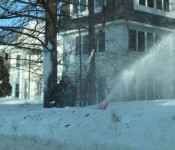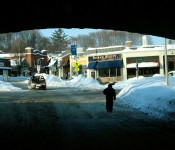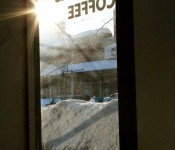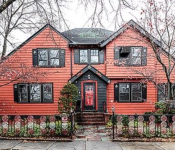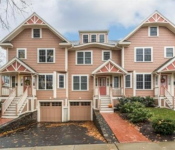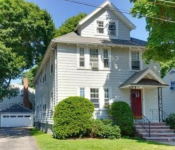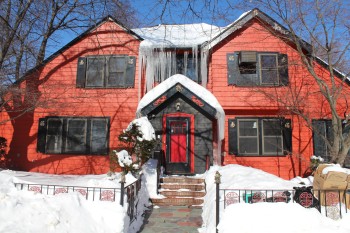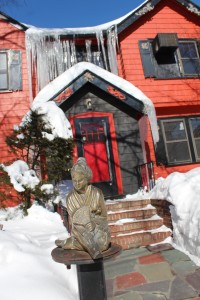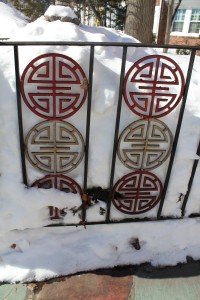Photo: Freshman Carey Allard handing off to anchor sophomore Marley Williams in the 4×200 meter relay in the MIAA Division 3 state championships held on Feb. 13, 2015.
Anoush Krafian has been on the high school track and field circuit for less than three months but the Belmont High School freshman has made it known that she is a young force to be reckoned with after a series of strong performances in league and class races.
On the biggest stage she’s been on so far on Friday afternoon at the MIAA Division 3 indoor track and field state championships at the Reggie Lewis Center in Roxbury, Krafian showed off her prodigious talents by nearly pulled off a stunning result, just miss winning a high jump state championship placing runner up to Chicopee High junior Mia Facchini. Facchini, Krafian and third place Meaghan Kelley from Tantasqua Regional High School all cleared 5 feet, 2 inches but their placements were determined by the number of jumps taken during the competition.
With that second place and another great result in the 55 meter hurdles, Krafian led Belmont High School Girls’ Indoor Track and Field team to a 9th place finish totaling 19 points, 12 coming from the freshman.
Krafian was the only 9th grader in the entire 24 competitor field for the 55-meter hurdles, reaching the finals after qualifying in the top eight. In the finals against seniors and juniors, Krafian sped over the five hurdles to a fifth-place finish, breaking the line in 9.05 seconds, an event won by defending champ senior Isabella DiMare from Notre Dame Hingham (who also won the 55-meter dash and placed third in the 300 meters) who took the top spot in 8.57.
Belmont’s other points came in two relays with the 4×200 meter with sophomore Julia Cella, junior Meggie MacAuley, freshman Carey Allard and sophomore Marley Williams taking third in 1:48.34 and the 4×400 with sophomore Alexandra Bailey, senior Lizzie Frick, sophomore Jenna Magno and junior Katherine Ognibene coming home in 4:21.59 for eighth place.

The Marauders brought a young team that could make considerably more noise next year as several individuals gained great experience:
- Williams ran a 7.64 in the 55 meter dash.
- Cella (43.02) finished 9th, Allard (43.29) 10th and MacAuley (44.38) 15th in the 300 meters.
- Bailey finished 11th (1:42.19) in the 600 meters.
- Sophomore Amelia Rasmussen ran a 3:13.36 in the 1,000 meters for 11th.
- Klimasmith took 10th in the 2 mile in 12:16.62.
- Joining Krafin in the hurdles were junior Samantha Kelts in 11th (9.63) and sophomore Rachel Berets in 18th in 9.8.
- Belmont’s 4×800 relay (junior Meredith Hughes, Klimasmith, sophomore Ally Meringer and Rasmussen) ran a 10:21.3 for 11th.
Over in the boys’ meet, a pair of seniors scored the eight points placing Belmont in a tie for 19th place.
Owen Madden came home in 5th in the 300 meters in 37.18, five one-hundreths of second out of fourth while Ari Silverfine ran a 2:36.86 to take 5th in the 1,000 meters. Both of Belmont’s relay teams just missed the points by finishing in 9th: 4×800 meter team of seniors Dan Rizzo, Charles Smith and Silverfine along with freshman Zach Tseng in 8:33.93 and the 4×400 meter of seniors John Decoulos, Madden, Silverfine and freshman Calvin Perkins coming home in 3:40.58, just a hundredth of a second behind Stoughton in eighth.








